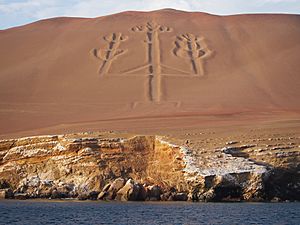Paracas Candelabra facts for kids
The Paracas Candelabra, also known as the Candelabra of the Andes, is a huge, ancient drawing on the ground. It's a type of geoglyph, which is a design made by arranging rocks or cutting into the earth. You can find it on the northern side of the Paracas Peninsula in Pisco Bay, Peru.
Scientists have found old pottery near the Candelabra. This pottery has been dated to about 200 BCE. This was the time of the Paracas culture, an ancient group of people. The Candelabra design is cut about 0.6 meters (2 feet) deep into the soil. Some stones might have been added around it later. The entire figure is about 183 meters (600 feet) tall. It's so big that sailors can see it from up to 19 kilometers (12 miles) away at sea!
In 2016, Peru officially named the Paracas Candelabra a national heritage site. This means it's a very important historical place. Peruvian law protects it, and damaging any ancient monument can lead to serious consequences.
History and Mysteries
Many interesting stories and ideas have come up about the Paracas Candelabra. Some people thought a famous leader named José de San Martín made it in the 1800s. He was important in Peru's fight for independence. Others believed it was a symbol used by a secret group called the Freemasons. There's also a popular idea that sailors created it as a special sign. They could use it to know they were close to land when sailing.
Some researchers even think the Candelabra might represent a "world tree." This is a special idea found in many ancient cultures, like the Mesoamerican world tree. It often shows a tree connecting the sky, earth, and underworld.
When Was It Made?
We don't know the exact age of the Candelabra geoglyph. But archaeologists have found pottery pieces around the site. These pieces date back to about 200 BCE. This pottery likely belonged to the Paracas people. However, we don't know for sure if the Paracas people were the ones who actually built the Candelabra.
Why Was It Created?
The reason why the Paracas Candelabra was made is still a mystery. Was it a guide for sailors? A religious symbol? Or something else entirely? Scientists and historians are still working to uncover its secrets.
See also
 In Spanish: Candelabro de Paracas para niños
In Spanish: Candelabro de Paracas para niños


